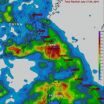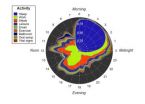(Press-News.org) FORT LAUDERDALE-DAVIE, Fla. – They are something we take very seriously in Florida – hurricanes. The names roll off the tongue like a list of villains – Andrew, Charlie, Frances and Wilma.
In the past 25 years or so, experts have gradually been improving prediction of the course a storm may take. This is thanks to tremendous advancements in computer and satellite technology. While we still have the "cone of uncertainty" we've become familiar with watching television weather reports, today's models are more accurate than they used to be.
The one area, however, where there is still much more to be researched and learned is in predicting just how intense a storm may be. While hurricane hunter aircraft can help determine wind speed, velocity, water temperature and other data, the fact is we often don't know why or how a storm gets stronger or weaker. There has been virtually no progress in hurricane intensity forecasting during the last quarter century.
But, thanks to new research being conducted, all that's about to change.
"The air-water interface – whether it had significant waves or significant spray – is a big factor in storm intensity," said Alex Soloviev, Ph.D., a professor at Nova Southeastern University's Oceanographic Center. "Hurricanes gain heat energy through the interface and they lose mechanical energy at the interface."
Soloviev is also an Adjunct Professor at the University of Miami Rosenstiel School of Marine and Atmospheric Science (UM RSMAS) and a Fellow at the Cooperative Institute for Marine and Atmospheric Studies (CIMAS.) He and his fellow researchers used a computational fluid dynamics model to simulate microstructure of the air-sea interface under hurricane force winds. In order to verify these computer-generated results, the group conducted experiments at the UM's Rosenstiel School Air-Sea Interaction Salt Water Tank (ASIST) where they simulated wind speed and ocean surface conditions found during hurricanes.
The study "The Air-Sea Interface and Surface Stress Under Tropical Cyclones" was published in the June 16, 2014 issue of the journal Nature Scientific Reports. Soloviev was the lead author of this study, which was conducted by a multi-institutional team including Roger Lukas (University of Hawaii), Mark Donelan and Brian Haus (UM RSMAS), and Isaac Ginis (University of Rhode Island.)
The researchers were surprised at what they found.
Under hurricane force wind, the air-water interface was producing projectiles fragmenting into sub millimeter scale water droplets. This process is known from some engineering applications, including rocket science, as the Kelvin-Helmholtz (KH) instability. This new study then looked at how changes in microphysics of the air-sea interface can make a storm grow or weaken in intensity. With wind speed exceeding a Category 1 threshold, the ocean surface unexpectedly became more "slippery."
When the wind exceeded Category 3 hurricane force, the "slippery" effect started gradually disappearing and was completely gone at Category 5. The conclusion was that some hurricanes might rapidly intensify to Category 3 and then stay in a "comfortable" zone around Category 3 status. This finding is consistent with the global best-track tropical cyclone statistics on maximum intensity for 1982-2009. So far, these early results showed that physical conditions where the air and the ocean interact must be a vital part of any successful hurricane forecasting model and would help explain, and predict, how a storm might intensify as it moves through across the water based on the physical stress at the ocean's surface.
This work has been supported by the NOPP project "Advanced coupled atmosphere-wave-ocean modeling for improving tropical cyclone prediction models" (PIs: Isaac Ginis, URI and Shuyi Chen, UM) and by the Gulf of Mexico Research Initiative (GoMRI) Consortium for Advanced Research on the Transport of Hydrocarbons in the Environment – CARTHE (PI: Tamay Özgökmen, UM). GoMRI is a 10-year, $500 million independent research program established by an agreement between BP and the Gulf of Mexico Alliance.
The plan is for the team to continue their research and experiments at UM's Alfred C. Glassell, Jr. SUSTAIN facility, which has recently been designed by one of the Nature article co-authors, Brian Haus (UM). It's the unique lab facility where they can recreate the conditions found in a Category 5 storm.
"We've got more work to do, but this is a great first step," Soloviev said. "But remember, no matter how good we get in predicting a storm's intensity, people in the path need to prepare accordingly regardless of what Category it is – that's most important."
INFORMATION:
About Nova Southeastern University:
Situated on 314 beautiful acres in Ft. Lauderdale, Florida, Nova Southeastern University (NSU) is a dynamic research institution dedicated to providing high-quality educational programs at all levels. NSU is a not-for-profit independent institution with 26,000 students. NSU awards associate's, bachelor's, master's, specialist, doctoral and first-professional degrees in a wide range of fields. NSU is classified as a research university with "high research activity" by the Carnegie Foundation for the Advancement of Teaching, and it is one of only 37 universities nationwide to also be awarded Carnegie's Community Engagement Classification. For more information, please visit http://www.nova.edu. Celebrating 50 years of academic excellence!
About NSU's Oceanographic Center: A world-class facility, the Center provides high-quality graduate education programs (i.e. master's, doctoral, certificate) in a broad range of marine science disciplines. Center researchers carry out innovative, basic and applied marine and research programs in coral reel biology, ecology, and geology; fish biology, ecology, and conservation; shark and billfish ecology; fisheries science; deep sea organismal biology and ecology; invertebrate and vertebrate genomics, genetics, molecular ecology, and evolution; microbiology; biodiversity; observation and modeling of large scale ocean circulation, coastal dynamics, and ocean atmosphere coupling; benthic habitat mapping; biodiversity; histology; and calcification. For more information, please visit http://www.nova.edu/ocean
NSU researcher part of team studying ways to better predict intensity of hurricanes
2014-07-25
ELSE PRESS RELEASES FROM THIS DATE:
NASA maps Typhoon Matmo's Taiwan deluge
2014-07-25
When Typhoon Matmo crossed over the island nation of Taiwan it left tremendous amounts of rainfall in its wake. NASA used data from the TRMM satellite to calculate just how much rain fell over the nation.
The Tropical Rainfall Measuring Mission or TRMM satellite orbits the Earth and provides coverage over the tropics. TRMM is a satellite that is managed by both NASA and the Japan Aerospace Exploration Agency (JAXA) that acts as a "flying rain gauge in space," that can estimate how fast rain is falling within storms on Earth and how much rain has fallen.
On July 22, ...
Shift work linked to heightened risk of type 2 diabetes
2014-07-25
Shift work is linked to a heightened risk of developing type 2 diabetes, with the risk seemingly greatest among men and those working rotating shift patterns, indicates an analysis of the available evidence published online in Occupational & Environmental Medicine.
Previous research has suggested links between working shifts and a heightened risk of various health problems, including digestive disorders, certain cancers, and cardiovascular disease. But whether diabetes can be added to the list has not been clear.
The authors therefore trawled through scientific research ...
Smartphone experiment tracks whether our life story is written in our gut bacteria
2014-07-25
Life events such as visiting another country or contracting a disease cause a significant shift in the make-up of the gut microbiota – the community of bacteria living in the digestive system, according to research published in the open access journal Genome Biology.
Two participants used smartphone apps to collect information every day for a year in the study by scientists from MIT and Harvard. The authors think the method could be rolled out to studies of human-bacteria relationships with many more participants.
Our microbiota is the community of bacteria that share ...
Leaf-mining insects destroyed with the dinosaurs, others quickly appeared
2014-07-25
After the asteroid impact at the end of the Cretaceous period that triggered the dinosaurs' extinction and ushered in the Paleocene, leaf-mining insects in the western United States completely disappeared. Only a million years later, at Mexican Hat, in southeastern Montana, fossil leaves show diverse leaf-mining traces from new insects that were not present during the Cretaceous, according to paleontologists.
"Our results indicate both that leaf-mining diversity at Mexican Hat is even higher than previously recognized, and equally importantly, that none of the Mexican ...
Monitoring the rise and fall of the microbiome
2014-07-25
CAMBRIDGE, MA -- Trillions of bacteria live in each person's digestive tract. Scientists believe that some of these bacteria help digest food and stave off harmful infections, but their role in human health is not well understood.
To help shed light on the role of these bacteria, a team of researchers led by MIT associate professor Eric Alm recently tracked fluctuations in the bacterial populations of two research subjects over a full year. The findings, described in the July 25 issue of the journal Genome Biology, suggest that while these populations are fairly stable, ...
Atomic structure of key muscle component revealed in Penn study
2014-07-25
VIDEO:
This is a representation of the atomic structure of tropomodulin at the minus end of the actin filament in muscle sarcomeres. Tropomodulin interacts with the first three actin subunits of...
Click here for more information.
PHILADELPHIA - Actin is the most abundant protein in the body, and when you look more closely at its fundamental role in life, it's easy to see why. It is the basis of most movement in the body, and all cells and components within them have the capacity ...
Increased risk for head, neck cancers in patients with diabetes
2014-07-25
Diabetes mellitus (DM) appears to increase the risk for head and neck cancer (HNC). Evidence suggests certain cancers are more common in people with DM, but the risk of HNC in patients with DM has not been well explored. Overall, head and neck cancer is the sixth most common type of cancer. It accounts for about 6 percent of all cases and for an estimated 650,000 new cancer cases and 350,000 cancer deaths worldwide each year.
The authors used Taiwan's Longitudinal Health Insurance Research Database to examine the risk of HNC in patients with DM. The authors compared 89,089 ...
8.2 percent of our DNA is 'functional'
2014-07-25
Only 8.2% of human DNA is likely to be doing something important – is 'functional' – say Oxford University researchers.
This figure is very different from one given in 2012, when some scientists involved in the ENCODE (Encyclopedia of DNA Elements) project stated that 80% of our genome has some biochemical function.
That claim has been controversial, with many in the field arguing that the biochemical definition of 'function' was too broad – that just because an activity on DNA occurs, it does not necessarily have a consequence; for functionality you need to demonstrate ...
Invertebrate numbers nearly halve as human population doubles
2014-07-25
Invertebrate numbers have decreased by 45% on average over a 35 year period in which the human population doubled, reports a study on the impact of humans on declining animal numbers. This decline matters because of the enormous benefits invertebrates such as insects, spiders, crustaceans, slugs and worms bring to our day-to-day lives, including pollination and pest control for crops, decomposition for nutrient cycling, water filtration and human health.
The study, published in Science and led by UCL, Stanford and UCSB, focused on the demise of invertebrates in particular, ...
Farmers market vouchers may boost produce consumption in low-income families
2014-07-25
Vouchers to buy fresh fruits and vegetables at farmers markets increase the amount of produce in the diets of some families on food assistance, according to research led by NYU's Steinhardt School of Culture, Education, and Human Development.
The study, which appears online in Food Policy, suggests that farmers market vouchers can be useful tools in improving access to healthy food. This finding validates a new program created by the Agricultural Act of 2014, or farm bill, that incentivizes low-income families to buy produce at farmers markets.
"In terms of healthy ...



